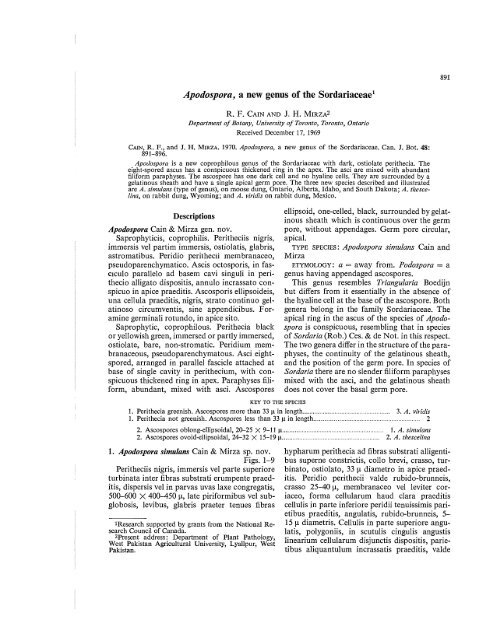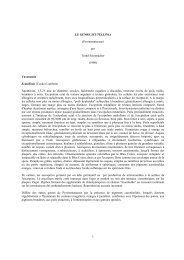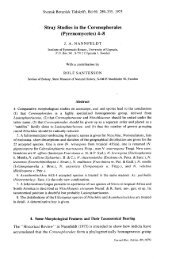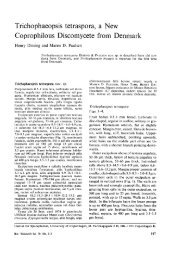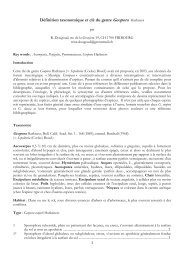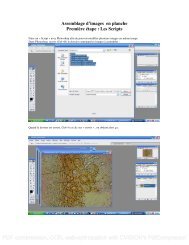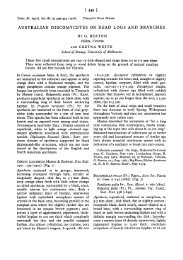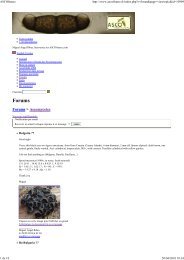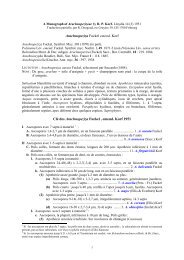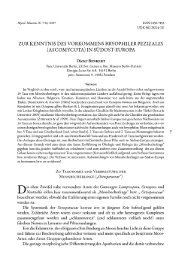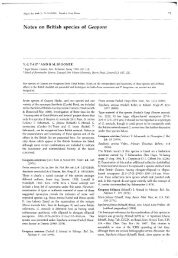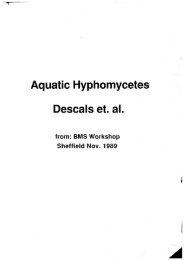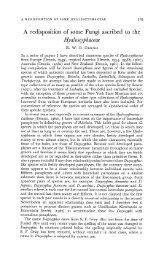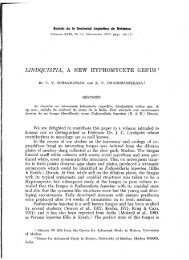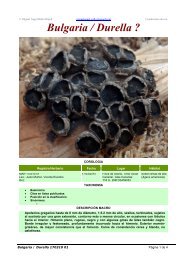Apodospora, a new genus of the Sordariaceael - ASCOfrance
Apodospora, a new genus of the Sordariaceael - ASCOfrance
Apodospora, a new genus of the Sordariaceael - ASCOfrance
Create successful ePaper yourself
Turn your PDF publications into a flip-book with our unique Google optimized e-Paper software.
<strong>Apodospora</strong>, a <strong>new</strong> <strong>genus</strong> <strong>of</strong> <strong>the</strong> <strong>Sordariaceael</strong>R. F. CAIN AND J. H. MIRZA~Department <strong>of</strong> Botat~y, University <strong>of</strong> Toronto, Toronto, OntarioReceived December 17, 1969CAIN, R. F., and J. H. MIRZA. 1970. <strong>Apodospora</strong>, a <strong>new</strong> <strong>genus</strong> <strong>of</strong> <strong>the</strong> Sordariaceae. Can. J. Bot. 48:891-896.<strong>Apodospora</strong> is a <strong>new</strong> coprophilous <strong>genus</strong> <strong>of</strong> <strong>the</strong> Sordariaceae with dark, ostiolate peri<strong>the</strong>cia. Theeight-spored ascus has a conspicuous thickened ring in <strong>the</strong> apex. The asci are mixed with abundantfiliform paraphyses. The ascospore has one dark cell and no hyaline cells. They are surrounded by agelatinous sheath and have a single apical germ pore. The three <strong>new</strong> species described and illustratedare A. simular~s (type <strong>of</strong> <strong>genus</strong>), on moose dung, Ontario, Alberta, Idaho, and South Dakota; A. <strong>the</strong>scelina,on rabbit dung, Wyoming; and A. viridis on rabbit dung, Mexico.Descriptions<strong>Apodospora</strong> Cain & Mirza gen. nov.Saprophyticis, coprophilis. Peri<strong>the</strong>ciis nigris,immersis vel partim immersis, ostiolatis, glabris,astromatibus. Peridio peri<strong>the</strong>cii membranaceo,pseudoparenchymatico. Ascis octosporis, in fasc~culoparallel0 ad basem cavi singuli in peri<strong>the</strong>cioalligato dispositis, annulo incrassato conspicuoin apice praeditis. Ascosporis ellipsoideis,una cellula praeditis, nigris, strato continuo gelatinosocircumventis, sine appendicibus. Foraminegerminali rotundo, in apice sito.Saprophytic, coprophilous. Peri<strong>the</strong>cia blackor yellowish green, immersed or partly immersed,ostiolate, bare, non-stromatic. Peridium membranaceous,pseudoparenchymatous. Asci eightspored,arranged in parallel fascicle attached atbase <strong>of</strong> single cavity in peri<strong>the</strong>cium, with conspicuousthickened ring in apex. Paraphyses filiform,abundant, mixed with asci. Ascosporesellipsoid, one-celled, black, surrounded by gelatinoussheath which is continuous over <strong>the</strong> germpore, without appendages. Germ pore circular,apical.TYPE SPECIES: <strong>Apodospora</strong> simulans Cain andMirzaETYMOLOGY: a = away from. Podospora = a<strong>genus</strong> having appendaged ascospores.This <strong>genus</strong> resembles Triangularia Boedijnbut differs from it essentially in <strong>the</strong> absence <strong>of</strong><strong>the</strong> hyaline cell at <strong>the</strong> base <strong>of</strong> <strong>the</strong> ascospore. Bothgenera belong in <strong>the</strong> family Sordariaceae. Theapical ring in <strong>the</strong> ascus <strong>of</strong> <strong>the</strong> species <strong>of</strong> <strong>Apodospora</strong>is conspicuous, resembling that in species<strong>of</strong> Sordaria (Rob.) Ces. & de Not. in this respect.The two genera differ in <strong>the</strong> structure <strong>of</strong> <strong>the</strong> paraphyses,<strong>the</strong> continuity <strong>of</strong> <strong>the</strong> gelatinous sheath,and <strong>the</strong> position <strong>of</strong> <strong>the</strong> germ pore. In species <strong>of</strong>Sordaria <strong>the</strong>re are no slender filiform paraphysesmixed with <strong>the</strong> asci, and <strong>the</strong> gelatinous sheathdoes not cover <strong>the</strong> basal germ pore.KEY TO THE SPECIES1. Peri<strong>the</strong>cia greenish. Ascospores more than 33 p in length ................................................. 3. A. viriclis1. Peri<strong>the</strong>cia not greenish. Ascospores less than 33 p in length .............................................................. 22. Ascospores oblong-ellipsoidal, 2&25 X 9-1 1 p ..................... . ..................... 1. A. simulans2. Ascospores ovoid-ellipsoidal, 24-32 X 15-19 p ........................................................ 2. A. <strong>the</strong>scelina1. <strong>Apodospora</strong> simulans Cain & Mirza sp. nov,Figs. 1-9Peri<strong>the</strong>ciis nigris, immersis vel parte superioreturbinata inter fibras substrati erumpente praeditis,dispersis vel in parvas uvas laxe congregatis,500-600 X 400-450 p, late piriformibus vel subglobosis,levibus, glabris praeter tenues fibras1Research supported by grants from <strong>the</strong> National ResearchCouncil <strong>of</strong> Canada.ZPresent address: Department <strong>of</strong> Plant Pathology,West Pakistan Agricultural University, Lyallpur, WestPakistan.hypharum peri<strong>the</strong>cia ad fibras substrati alligentibussuperne constrictis, collo brevi, crasso, turbinato,ostiolato, 33 p diametro in apice praeditis.Peridio peri<strong>the</strong>cii valde rubido-brunneis,crasso 25-40 p, membranaceo vel leviter coriaceo,forma cellularum haud clara praeditiscellulis in parte inferiore peridii tenuissimis parietibuspraeditis, angulatis, rubido-brunneis, 5-15 p diametris. Cellulis in parte superiore angulatis,polygoniis, in scutulis cingulis angustislinearium cellularum disjunctis dispositis, parietibusaliquantulum incrassatis praeditis, valde
892 CANADIAN JOURNAL OF BOTANY. VOL. 48. 1970rubido-brunneis, haud translucidis. Ascis octosporis,cylindraceis, superne late rotundatis,annulo claro incrassato in apice sito praeditis,inferne in stipitem longissimum gracilem crocabasi praeditum paulatim attenuatis, 250-350 X13-1 6 p. Paraphysibus filiformibus, septatis,hyalinis, numerosis, cum ascis mixtis, 3-4 p diametris.Ascosporis uniseriatis, plerumque ascoin parte superiore obliquis et in parte inferioreparallelis et minus stipatis, 20-25 X 9-11 p,oblongo-ellipsoideis, uniguttulatis, deinde olivaceo-brunneis,postremo paene nigris et haudtranslucidis, foramine germinali hyalino, rotundo,in apice sito, 2 p diametro, in parvotuberculo posito praeditis, strato mucoso continuo,hyalino, crasso 3-5 p, super foramen germinalenon interrupt0 circumventis. Mycelio inagaro cano-brunneo, aerio; phialidibus numer-osis in hyphis sparsis. Phialidibus pallido-brunneis,apice dilato praeditis. Phialosporis parvis,ovatis, in globo in apice phialidis dispositis.TYPUS: in fimo Alcis americatzae, Twp. lB,Little White River, Algoma D., Ontario, Canada,15 Sept. 1956, Cain, TRTC 32365. In University<strong>of</strong> Toronto Cryptogamic Herbarium.Peri<strong>the</strong>cia black, immersed or with upper conicalpart erumpent between fibers <strong>of</strong> substratum,dispersed or loosely aggregated in small clusters,500-600 X 400450 p, broadly pyriform to subglobose,smooth, bare except for fine hyphalfilaments by means <strong>of</strong> which <strong>the</strong>y are closely adherentto fibers <strong>of</strong> substratum, constricted aboveto form a very short, stout, conical neck with acircular ostiole, 35 p in diameter at apex. Peri<strong>the</strong>cialperidium dark reddish-brown, 2540 p inthickness, membranaceous to slightly coria-FIGS. 1-2. Apodosporn sitnulans. Fig. 1. Two peri<strong>the</strong>cia.X 80. Fig. 2. Cells in upper part <strong>of</strong> peridiurnshowing areas <strong>of</strong> elongated cells, surface view. X 700.FIGS. 3-5. A. simulans. X 700. Fig. 3. Cells <strong>of</strong> lowerpart <strong>of</strong> peridiurn, surface view. Fig. 4. Two asci with veryyoung ascospores. Fig. 5. Immature ascospores.
CMN AND MIRZA: APODOSPORA 893ceous, with cellular structure obscure. Cells inlower part <strong>of</strong> peridium very thin-walled, angular,reddish-brown, 5-15 pin diameter. Cells in upperpart angular, polygonal, arranged in platesseparated by narrow zones <strong>of</strong> linear cells, withwalls slightly thickened, dark reddish-brown,very opaque. Asci eight-spored, cylindrical,broadly rounded above, with a distinct thickenedring in apex, tapering gradually below into avery long slender stipe with a crozier at <strong>the</strong> base,250-350 X 13-1 6 p. Paraphyses filiform, septate,hyaline, abundant, mixed with asci, 3-4 indiameter. Ascospores uniseriate, usually lyingoblique to ascus in upper part and parallel andless crowded in lower part, 20-25 X 9-11 p,oblong-ellipsoidal, with one large refractive globule,becoming olivaceous-brown and finallynearly black and opaque, with hyaline, circular,apical germ pore measuring 2 p in diameterlocated in a small, tubercular projection, surroundedby a continuous, gelatinous, hyalinesheath measuring 3-5 p in thickness and notinterrupted over germ pore. In culture producingcolonies with gray-brown aerial mycelium withabundant phialides scattered on hyphae. Phialideslight brown, with flaring collarette. Phialosporessmall, ovate forming globose mass at apex<strong>of</strong> phialide.ETYMOLOGY: Latin, simulans = imitating, from<strong>the</strong> superficial resemblance to Sordaria jimicola(Rob.) Ces. & de Not.HABITAT: on dung <strong>of</strong> moose. A single collectionrecorded on cow dung.SPECIMENS EXAMINED: All specimens collectedon moose dung by Cain unless stated o<strong>the</strong>rwise.CANADA: ONTARIO: Algoma D.: Twp. 1 B, LittleFIG. 6. A. sirnulans. X 700. Asci with immature, partiallycolored ascospores.FIGS. 7-8. A. simulans. X 700. Fig. 7. Asci withmature ascospores. Fig. 8. Mature ascospores.
896 CANADIAN JOURNAL OF BOTANY. VOL. 48, 1970TYPUS: in fimo cuniculorum, W <strong>of</strong> Durango,Mexico, 14 Aug. 1960, Cain, TRTC 36798. InUniversity <strong>of</strong> Toronto Cryptogamic Herbarium.Peri<strong>the</strong>cia scattered, superficial or with baseslightly immersed, 700-1300 X 390-550 p, pyriform;light yellowish green, lower part coveredwith thin, fugacious greenish tomentum; neckconical, stout, black, covered with thin papillae;peridium thin, membranaceous, semitransparent,with small angular cells. Asci eight-spored (orless commonly four- or two-spored by abortion<strong>of</strong> four or more spores), cylindrical, narrowlyrounded above with an apical ring in apex. Ascosporesuniseriate, ellipsoidal, (34-)48-53(-66) X(19-)29-31(-35) p, almost black and opaque, gelatinoussheath very fugacious and continuousover <strong>the</strong> germ pore. Germ pore apical, about 2.5p in diameter. Conidial stage green, floccose, onsurface <strong>of</strong> dung. Phialides <strong>of</strong> short cubical cellsforming branched chains each with an openingand short collarette. Phialospores small, ovoid,3.0-3.5 X 2.5-3.0 p.ETYMOLOGY: Latin, viridis = green.HABITAT: rabbit dung.SPECIMENS EXAMINED: TRTC 36798, type.This species can be separated from <strong>the</strong> o<strong>the</strong>rtwo by its greenish peri<strong>the</strong>cia, and <strong>the</strong> largerdimensions <strong>of</strong> <strong>the</strong> asci and ascospores. The asci,although normally eight-spored, quite <strong>of</strong>ten becomefour-spored or rarely even two-spored because<strong>of</strong> <strong>the</strong> abortion <strong>of</strong> ascospores at an earlystage <strong>of</strong> development.


